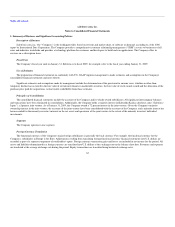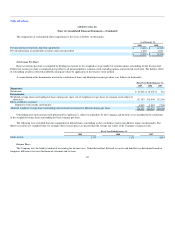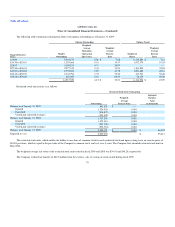Salesforce.com 2008 Annual Report Download - page 73
Download and view the complete annual report
Please find page 73 of the 2008 Salesforce.com annual report below. You can navigate through the pages in the report by either clicking on the pages listed below, or by using the keyword search tool below to find specific information within the annual report.
Table of Contents
salesforce.com, inc.
Notes to Consolidated Financial Statements—(Continued)
customer for fixed price contracts. The majority of the Company's consulting contracts are on a time and materials basis. Training revenues are recognized
after the services are performed. For revenue arrangements with multiple deliverables, such as an arrangement that includes subscription, premium support,
consulting or training services, the Company allocates the total amount the customer will pay to the separate units of accounting based on their relative fair
values, as determined by the price of the undelivered items when sold separately.
In determining whether the consulting services can be accounted for separately from subscription and support revenues, the Company considers the
following factors for each consulting agreement: availability of the consulting services from other vendors, whether objective and reliable evidence for fair
value exists for the undelivered elements, the nature of the consulting services, the timing of when the consulting contract was signed in comparison to the
subscription service start date, and the contractual dependence of the subscription service on the customer's satisfaction with the consulting work. If a
consulting arrangement does not qualify for separate accounting, the Company recognizes the consulting revenue ratably over the remaining term of the
subscription contract. Additionally, in these situations, the Company defers only the direct costs of the consulting arrangement and amortizes those costs over
the same time period as the consulting revenue is recognized. As of January 31, 2009 and January 31, 2008, the deferred cost on the accompanying
consolidated balance sheet totaled $17.3 million and $13.9 million, respectively. These deferred costs are included in prepaid expenses and other current
assets and other assets.
Deferred Revenue
Deferred revenue primarily consists of billings or payments received in advance of revenue recognition from the Company's subscription service
described above and is recognized as the revenue recognition criteria are met. The Company generally invoices its customers in annual or quarterly
installments. Accordingly, the deferred revenue balance does not represent the total contract value of annual or multi-year, non-cancelable subscription
agreements. Deferred revenue also includes certain deferred professional services fees which are recognized as revenue ratably over the subscription contract
term. The Company defers the professional service fees in situations where the professional services and subscription contracts are accounted for as a single
unit of accounting. Deferred revenue that will be recognized during the succeeding 12-month period is recorded as current deferred revenue and the remaining
portion is recorded as noncurrent. Approximately 7 percent and 8 percent of total deferred revenue as of January 31, 2009 and January 31, 2008, respectively,
related to deferred professional services revenue.
Deferred Commissions
Deferred commissions are the incremental costs that are directly associated with non-cancelable subscription contracts with customers and consist of
sales commissions paid to the Company's direct sales force. The commissions are deferred and amortized over the non-cancelable terms of the related
customer contracts, which are typically 12 to 24 months. The commission payments are paid in full the month after the customer's service commences. The
deferred commission amounts are recoverable through the future revenue streams under the non-cancelable customer contracts. The Company believes this is
the preferable method of accounting as the commission charges are so closely related to the revenue from the non-cancelable customer contracts that they
should be recorded as an asset and charged to expense over the same period that the subscription revenue is recognized. Amortization of deferred
commissions is included in marketing and sales expense in the accompanying consolidated statements of operations.
70
























